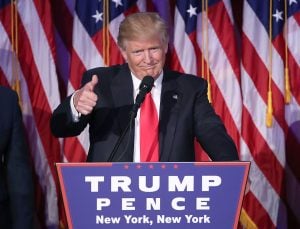
President-elect Donald Trump (Photo by Mark Wilson/Getty)
For eight long years, King Obama has committed constitutional anarchy. Rather than respecting the limits of his power, the former constitutional law lecturer spent his time in office trampling the very document he purported to teach.
But in just over 24 hours, America will be replacing a monarch with a president, intent on respecting the constitutionally prescribed limits on his power. President-elect Donald Trump will undo the executive overreach that has long plagued our democracy – a tall order given the breadth and scope of despotic Obama administration overreach.

Generative AI Facts And Fallacies
Four insights and misunderstandings to help demystify GenAI for legal professionals.
For those who have forgotten Obama’s flagrant abuses of power, let’s take a stroll down memory lane and run through some of his greatest hits.
First, there was the time that Obama opted to unilaterally erase part of the United States Code. Despite saying 22 times to millions of Americans that he lacked the authority to confer legal status on certain undocumented immigrants, he used an executive order to rescind parts of the Immigration and Nationality Act and grant what amounted to legal status for five million of them.
Obama acted out only to be rebuffed by the Fifth Circuit, which called Obama’s executive action “‘manifestly contrary’ to the INA… [which] flatly does not permit the reclassification of millions of illegal aliens as lawfully present… .” In a 4-4 decision, the Supreme Court let the ruling stand.
Then there was Obama’s reinterpretation of gun laws. “Congress still needs to act… But we also can’t wait,” Obama remarked. And wait he did not.

Skills That Set Firms Apart
Legal expertise alone isn’t enough. Today’s most successful firms invest in developing the skills that drive collaboration, leadership, and business growth. Our on-demand, customizable training modules deliver practical, high-impact learning for attorneys and staff—when and where they need it.
The Brady Bill provides for two separate categories of gun purchases – a business and a non-business category. The former category necessitates background checks while the latter does not. Congress intentionally made this distinction. Obama reinterpreted “business,” essentially combining the two categories and making nearly all purchasers subject to background checks.
House Speaker Paul Ryan accurately responded, “[T]he president is at minimum subverting the legislative branch, and potentially overturning its will… His proposals to restrict gun rights were debated by the United States Senate, and they were rejected.”
And perhaps worst of all was the time “Obama opted to implement the will of Iran over the will of Congress.” In an effort to please the murderous, despotic government of Iran, Obama acted despotically himself in eviscerating part of Congress’ Visa Waiver Program, choosing to please Iran while snubbing the Constitution and putting national security at risk.
The Visa Waiver Program (VWP) permits citizens of certain countries to come to America for 90 days without needing a visa. In the wake of the November 2015 Paris terrorist attacks that left 130 dead, changes were made to the program duly enacted by Congress and signed by Obama himself. According to the new law, those who have traveled to terror-ridden countries, including Iran, may not enter the country using the lax VWP.
Obama’s support of the law changed during his negotiations of the Iran nuclear deal. Under pressure from Iran and desperate to shore up his foreign policy legacy, Obama agreed to again unilaterally change the United States Code via the Iranian nuclear deal, which should have always been treated as a treaty requiring two-thirds Senate approval (another of Obama’s extralegal acts!).
Obama unilaterally changed the VWP by abusing a provision in the 2015 law. The law provided that the president could waive the new visa requirements where it was “in the law enforcement interest or national security interest of the United States.” Obama used this narrow exception to make an additional exception for those coming from Iran for “legitimate business-related purposes.” He did this even though Congress rejected this very exception when debating the text of the bill!
To make matters worse, Obama’s flurry of unconstitutional actions was not the result of naiveté but intentional disregard for the law. In the face of divided government, Obama chose to change our democracy into a monarchy, with Republican opposition in Congress as his rationale.
“When Congress refuses to act, Joe and I are going to act,” Obama vowed in 2012. “We are not just going to wait for legislation in order to make sure that we’re providing Americans the kind of help that they need. I’ve got a pen, and I’ve got a phone,” he stated two years later.
But as President-elect Trump promisingly observed: “[T]he one thing good about executive orders: the new president, if he comes in – boom, first day, first hour, first minute, you can rescind that.”
On the micro level, Trump pledged to void Obama’s 2014 immigration executive order, before the judiciary struck it down. With regard to guns, he has vowed to “unsign” Obama’s executive order, noting, “I don’t like anything having to do with changing our Second amendment.”
And on the macro level, Trump said, “One of the problems I have with what Obama did is he’s always signing executive orders.” Despite Trump’s keen awareness of Obama’s overuse of executive orders, Obama audaciously took it upon himself to warn the incoming president about not using the executive order.
Obama explained, “My suggestion to the president-elect is, you know, going through the legislative process is always better… .”
This from the President who waged an executive coup d’etat on his coequal branch of government.
 Kayleigh McEnany is a CNN political commentator. She is a graduate of Harvard Law School and Georgetown University’s School of Foreign Service, and she also studied politics at Oxford University. In addition to writing a column for Above the Law, she is a contributor for The Hill. She can be found on Twitter at @KayleighMcEnany.
Kayleigh McEnany is a CNN political commentator. She is a graduate of Harvard Law School and Georgetown University’s School of Foreign Service, and she also studied politics at Oxford University. In addition to writing a column for Above the Law, she is a contributor for The Hill. She can be found on Twitter at @KayleighMcEnany.